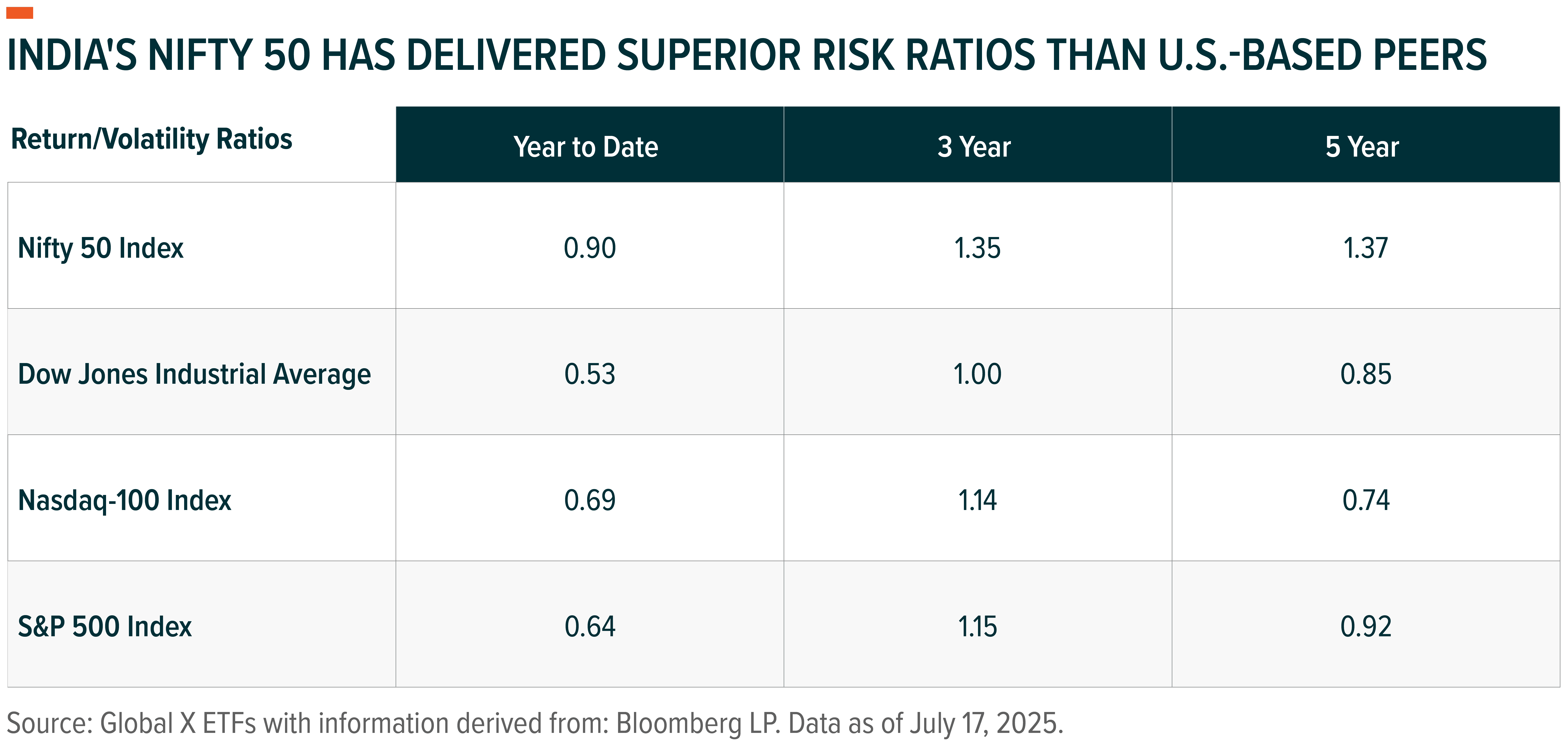We believe India’s compelling demographics, market friendly governance, and distinctive risk/return profile make it an attractive standalone investment.
Key Takeaways
- Diversification Benefits: The MSCI India Index has a low correlation to both Emerging Market (EM) and Developed Market (DM) equities.
- Structural Growth Advantage: India likely has an advantage over many EM peers given its market friendly governance, position as a China+1 beneficiary, young population, and growing international trade ties.
- Historically Superior Returns: India's three- and five-year volatility-adjusted equity returns have outpaced both broad EM and U.S. markets.
The Value of Diversification: India offers uncorrelated exposures relative to other EMs and DMs
- Domestically Driven Market: The MSCI India Index has a low correlation and beta of ~0.5 to the broader MSCI EM Index and a correlation of below 0.2 to U.S. equities as measured by the S&P 500 Index.1
- The Benefits of Gold: Indian equites typically offer positive exposure to high gold prices, due to cultural demand and gold-backed rural wealth.
- U.S. Dollar Impact: India generally benefits from a weak U.S. dollar, as this trend improves capital flows, lowers import costs, and strengthens rupee-denominated assets.
- Net Oil Importer: India imports nearly 90% of its oil consumption, so lower oil prices ease its current account deficit and inflation.2
 The Best of Emerging Markets: For allocators wary of EM’s macro instability or geopolitical risk, India stands apart
The Best of Emerging Markets: For allocators wary of EM’s macro instability or geopolitical risk, India stands apart
- Market-friendly government: Prime Minister Modi’s Bharatiya Janata Party (BJP) continues to prioritize infrastructure, digitization, and capex-led growth.3
- Demographics: India recently surpassed China as the most populous nation in the world. The country now has the world’s largest general and youth populations, with 65% of people below 35 years old.4
- China+1 Winner: Manufacturing FDI (foreign direct investment) inflows have been rising as firms diversify their supply chains. For example, Apple now manufactures roughly 20% of its iPhones in India.5
- Strategic Global Trade Partner: Despite finding itself at the center of the most recent trade negotiation with the Trump White House, we believe India has powerful leverage in terms of an inexpensive, talented, and educated manufacturing base for the world. The most recent free trade agreement with the U.K. is powerful, and we are optimistic on an eventual resolution with the U.S.
Profitable Growth: India is forecast to remain the world’s fastest-growing major economy6
- GDP Growth: The International Monetary Fund projects that India’s GDP will increase at a 6.5–7.0% compound annual growth rate (CAGR) through 2027.7
- Corporate Profitability: With available data back to 2003, Indian companies have delivered an average return on equity of 17.21%, well above the market’s cost of capital and EM averages.8 Given India’s deepening capital market system, Central Bank rate cuts, and improving corporate governance, we believe this spread can widen.
- Formalization & Digitization: GST (goods and services tax) rollout, Aadhaar ID (a unique digital identity program that helps over 95% of Indians access essential services and fosters financial inclusion)9, and UPI (Universal Payment Infrastructure, which helps formalize the economy by creating a need for digital transactions) payments should drive up the tax base and increase productivity, all while improving fiscal balances.
- Private Capex Cycle Rebound: Corporate balance sheets have deleveraged, signaling space for significant bank loan growth.10
Risk Adjusted Returns: Despite historical perceptions of volatility, India has delivered superior risk ratios in recent years
- Returns Over Volatility: India’s three-year and five-year return/volatility ratios were above the Dow Jones, the S&P 500, and the NASDAQ in the first half of 2025.11
- Domestic Flows: A strong mutual fund SIP (systematic investment plan) culture may help stabilize markets during global outflows.12

Conclusion
In our view, India is not only a standout within EM, it is a structurally distinct growth engine that warrants standalone consideration across broad equity portfolios. Its relatively low correlation with other risk assets, robust fundamentals, and reform-driven governance offer both diversification and alpha potential. While India is still an Emerging Market and subject to volatility in terms of geopolitics, trade, foreign exchange, etc., we believe the country’s benefits come without the same level of macro volatility associated with many EM peers. In summary, we see India as an attractive standalone investment opportunity.